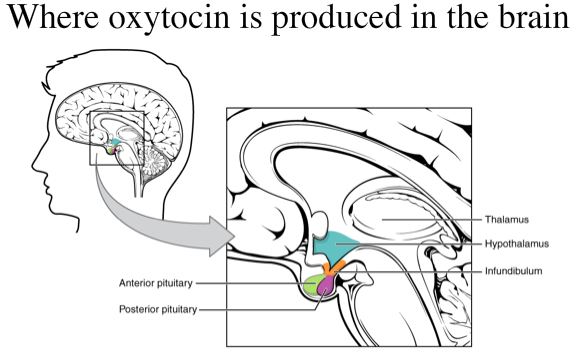February, the month of love!
Have you ever wondered what happens in your body when you feel love, connection and care? Has it been curious to you that we say words like heartfelt, heartbreak and heartache? Why is the heart a symbol of love? Part of the answer lies in the “love hormone,” oxytocin.
So, what is oxytocin? Well, it looks like this:
And makes us feel like this:
Oxytocin is a hormone secreted by the pituitary glad -a pea-sized structure in the hypothalamus at the base of the brain.
The function of oxytocin has been well documented:
- Contraction of the uterus during childbirth: Oxytocin stimulates uterine muscles to contract and also increases production of fatty acid compounds called prostaglandins which further contract the uterus
- Breastfeeding: Oxytocin promotes the movement of milk into the breast when a baby suckles
- Mother-child bonding: Studies found that women with higher oxytocin levels during pregnancy bonded more closely with their babies
- Cardiovascular actions: Oxytocin lowers blood pressure and regulates pulse rate
- Human connection: Oxytocin is an important component in bonding, orgasm, maternal behaviour and social recognition. When we hug a loved one, oxytocin production increases, which is why it is sometimes referred to as the “love hormone”
The heart-oxytocin “Love Connection”
Your heart also produces oxytocin, particularly in the small chambers of your heart called the atria. In fact, research has found that concentrations of oxytocin in the atria were as high as those in the hypothalamus.
Further studies reveal that connections between social behavior, oxytocin and the central nervous system have an influence on the heart. This indicates that oxytocin may be involved in the link between social behavior and cardiovascular health.
In rat studies, oxytocin was shown to have a cardioprotective effect. This means that oxytocin may help the heart heal after an event such a heart attack. Theoretically, this is a result of oxytocin bathing the heart when it’s exposed to a stressor such as vigorous exercise or a startling event.
How to Produce Oxytocin Naturally
To name a few…
- Physical touch such as massage, cuddling, hugs
- Repetitive, rhythmic movement such as dancing or yoga
- Whole body exercise such as cycling, rowing or dance
- Playing or listening to music
- Receiving and giving care
- Lovemaking, orgasm, sexual intercourse or masturbation
- Meditation, prayer or visualizations
So, this February, give yourself and those you care about some “love hormone” and feel your heart swell!
References:
- J. Gutkowska, M. Jankowski, S. Mukaddam-Daher and S.M. McCann, 2014 in: Braz J Med Biol Res. “Oxytocin is a cardiovascular hormone” from Pennington Biomedical Research Center, Louisiana State University USA.
- Maryam Moghimian PhD et. al., 2013 in: Journal of Cardiology. “The role of central oxytocin in stress-induced cardioprotection in ischemic-reperfused heart model” from Department of Physiology, School of Medicine, Gonabad University of Medical Science, Gonabad, Islamic Republic of Iran.
- Ali Mohammad Alizadeh et. al., 2010 in: Peptides. “Oxytocin protects rat heart against ischemia–reperfusion injury via pathway involving mitochondrial ATP-dependent potassium channel” from Department of Physiology, School of Medicine, Tehran University of Medical Science, Enghelab Ave, Enghelab Squ, Tehran, Islamic Republic of Iran.
- Kai MacDonald MD, David Feifel MD, PhD, 2012 in: The Journal of Sexual Medicine. “Dramatic Improvement in Sexual Function Induced by Intranasal Oxytocin” from University of California, San Diego Medical Center Department of Psychiatry, San Diego, CA, USA.
- Richard Ivell et. al., 2018 in: Biomedical Sciences. “Oxytocin” from University of Nottingham, Sutton Bonington, United Kingdom.
- Behnoush Behnia et. al., 2014 in: Hormones and Behaviour. “Differential effects of intranasal oxytocin on sexual experiences and partner interactions in couples” from Department of Psychiatry, Social Psychiatry and Psychotherapy, Hannover Medical School, Carl-Neuberg Strasse 1, D-30625 Hanover, Germany.
- Qing Xin Bo Bai Wenyan Liu, 2017 in: Neurochemistry International. “The analgesic effects of oxytocin in the peripheral and central nervous system” from Department of Physiology, Jining Medical University, Jining, 272067, China.
- Masood Aali Anvari et. al. in: European Journal of Pharmacology. “The administration of oxytocin during early reperfusion, dose-dependently protects the isolated male rat heart against ischemia/reperfusion injury” from Department of physiology, School of Medicine, Tehran University of Medical Sciences, Tehran, Iran.
- Natasha K. Sriraman MD, MPH, FAAP, FABM in: Current Problems in Pediatric and Adolescent Health Care. “The Nuts and Bolts of Breastfeeding: Anatomy and Physiology of Lactation” from Division of General Academic Pediatrics, Children’s Hospital of The King’s Daughters, Eastern Virginia Medical School, Norfolk, VA, USA.
Share this Post



